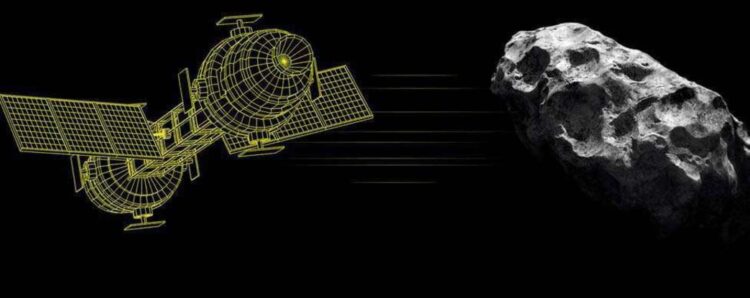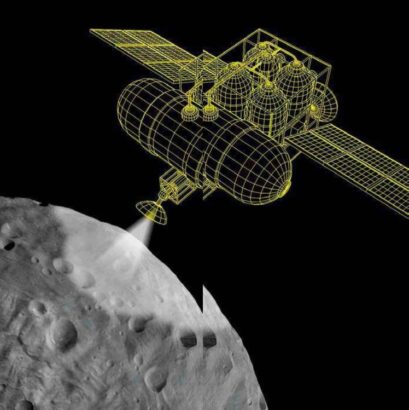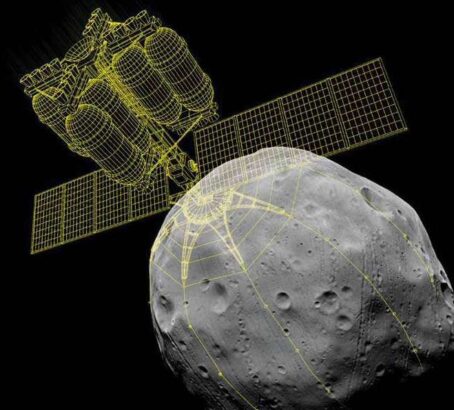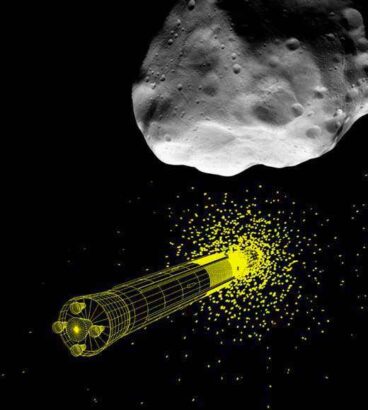Put a drill on the asteroid to vaporize it
Imagined in the 1990s to get rid of space debris, this option exploits the law of action-reaction which allows rockets to take off. Except that instead of ejecting gases resulting from combustion, this time we would eject the material of the asteroid itself thanks to a flotilla of probes equipped with lasers or ion cannons: by concentrating their rays on the asteroid to vaporize its material, we would create a flow on the surface which would generate thrust in the opposite direction. For Massimiliano Vasile (University of Strathclyde), laser ablation is the best non-nuclear alternative to the kinetic impactor. Problem: we don’t know how to gather enough energy to power the cannons. Hence a variant powered by magnifying glasses concentrating the light of the Sun. But if the asteroid turns on itself, it will be difficult to focus the beams in the same place, estimates Patrick Michel (Dart mission). Hence, the last option: install a drill and a cannon on its surface to eject the material into space. However, landing is even more complicated, points out Jean-Yves Prado (ex-Cnes). In short, the method is beautiful, no doubt effective, but it remains a challenge.
ASTEROIDS TARGETED
All
TIME BEFORE IMPACT
Several years
ADVANTAGE
The asteroid provides its own propulsion
LIMIT
The rotation of the asteroid on itself
DEGREE OF MATURITY
Medium
Betting on universal attraction to divert its trajectory
This rather elegant principle was described in the journal Nature in 2005 by officials of the American foundation B612, created by former astronauts mobilized against the asteroid threat. It consists of exploiting Newton’s law of universal attraction: every body attracts the bodies around it. If we manage to send a probe near the asteroid, it could therefore attract it in its direction. “But the asteroid will also attract the probe, which will have to resist with the help of a propellant to drive the asteroid in the desired direction”, explains Francis Rocard, from Cnes. Contactless towing, of sorts. But this force will be so weak that the probe will have to maintain this perilous stationary flight for years, even tens of years (the slightest failure of the engine throwing it on the asteroid). Hence a mode of propulsion without fuel, like an ion engine powered by solar panels. But this technique, which will propel Dart, is far from having demonstrated such endurance.
“In addition, launching very massive probes remains difficult, which restricts this technique to very small asteroids, less than 100 m, whose trajectory is predictable very far in advance”, specifies Jean-Yves Prado (ex-Cnes). The Asteroid Redirect Mission, which was dedicated to him by NASA, was canceled at the end of 2017.
ASTEROIDS TARGETED
Less than 100 m
TIME BEFORE IMPACT
several decades
ADVANTAGE
Unaffected by object shape and composition
LIMIT
Requires hovering for decades
DEGREE OF MATURITY
Medium
Paint its surface white to change its albedo
This is the most creative approach. It assumes that asteroids, like any celestial body, are exposed to solar radiation, which they partly re-emit in the form of thermal radiation (albedo), generating thrust in the opposite direction. A small push, but continuous. Hence the idea of Ivan Nemchinov and Henry Melosh, in 1993, to develop methods aimed at modifying the ability of the asteroid to receive or re-emit photons in the desired direction. We were looking for a method as effective as nuclear, but which could not be used as a weapon against the Earth, recalls Henry J. Melosh (Purdue University). Hence the idea of… modifying the radiative emission of the asteroid by painting it partly white! It was enough to think about it… Yes, but concretely? By spraying the asteroid with a reflective powder that would cover it under the effect of gravity? Even if we succeeded, it would still be necessary to control this effect, knowing that the asteroid does not turn on itself, objects Patrick Michel (Dart mission). By positioning probes between the Sun and it that would deploy sails to shade it? This fleet would reposition itself permanently, argues Jean-Yves Prado, co-inventor of this technique. Be that as it may, it would be necessary to act for several decades to obtain a sufficient deviation. Which means having the time!
ASTEROIDS TARGETED
All
TIME BEFORE IMPACT
several decades
ADVANTAGE
No push to provide
LIMIT
Very low power, which requires a lot of time
DEGREE OF MATURITY
Weak
Capture the asteroid to tow it
The method was devised a few years ago with the aim of capturing an asteroid to exploit its resources: it involved fixing a cable or imprisoning it using articulated arms, a net or a big bag, then tow it with a rocket. A technique in truth much less easy than it seems. I hang on with a rocket and then I pull, or I push But it’s not so easy, because the asteroid turns on itself, recalls Francis Rocard, from Cnes. Not to mention that if some asteroids are rocky or metallic, others are clumps of matter without much cohesion, on which it would be difficult to anchor firmly. A simplified version of towing avoids this pitfall: it would involve landing on the asteroid and using the rocket propellant to push it. But even so, the technique would require the development of engines that do not currently exist. A conventional chemical propellant, although powerful, requires too large quantities of fuel; and an electric motor powered by solar energy does not provide sufficient thrust. “It’s a bit like wanting to pull an aircraft carrier with a boat”, summarizes Jean-Yves Prado (ex-Cnes). In short, with competition from the gravity tractor, towing remains one of the least mature methods of dealing with danger.
ASTEROIDS TARGETED
Less than 100 m
TIME BEFORE IMPACT
Several years
ADVANTAGE
Rockets are already available
LIMIT
Requires grounding and strong power, or a lot of time
DEGREE OF MATURITY
Very weak
Deflect it with a nuclear warhead
This is one of the first methods considered, promoted by Edward Teller, the father of the atomic bomb himself: purely and simply pulverizing the asteroid using a warhead placed in a rocket. “The option is clearly the best in most cases, provided it doesn’t fragment the asteroid. Because the rain of radioactive debris could prove to be worse than the initial impact”, summarizes Massimiliano Vasile (University of Strathclyde). Hence the idea studied today to detonate the bomb from a distance (a few hundred meters or more), to preserve the asteroid, while giving it enough energy to deflect it in the desired direction. Another advantage: it is one of the only methods that could work on all body types, with an instant effect. “For an asteroid larger than 100m, with a reaction time of only a few years before impact, this could be our only viable option,” confirms Lindley Johnson, director of NASA’s planetary defense program. But the option remains debated, because international regulations prohibit the use of nuclear weapons in space.
“We will probably never be able to test it, recognizes Patrick Michel (Dart mission). But it’s not worth it: we know it works. “As long as you master it!
ASTEROIDS TARGETED
All
TIME BEFORE IMPACT
6 months to a year
ADVANTAGE
Power of thrust obtained
LIMIT
Risk of creating a rain of fragments, just as dangerous
DEGREE OF MATURITY
Very high
We would love to give thanks to the writer of this post for this incredible content
Asteroids: 5 solutions to defend the Earth
You can view our social media profiles here , as well as other related pages herehttps://nimblespirit.com/related-pages/




